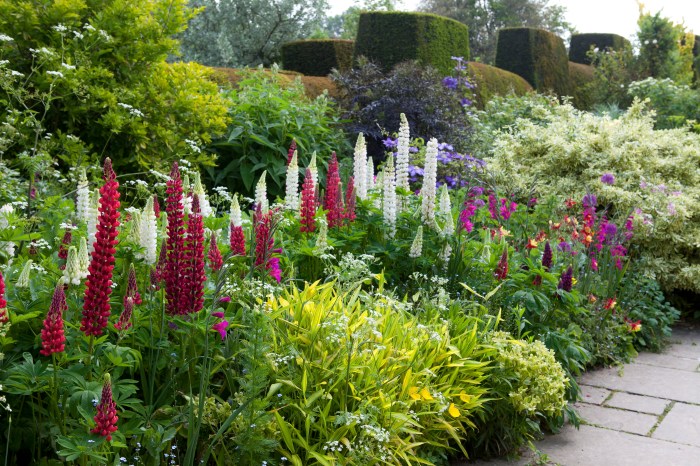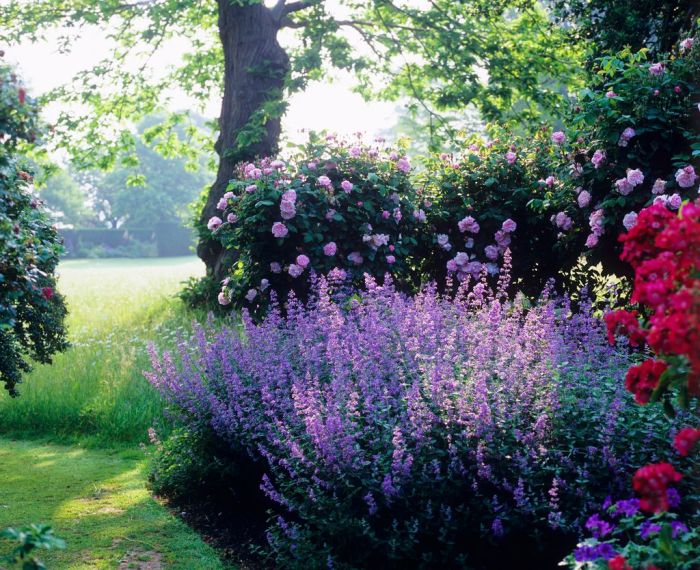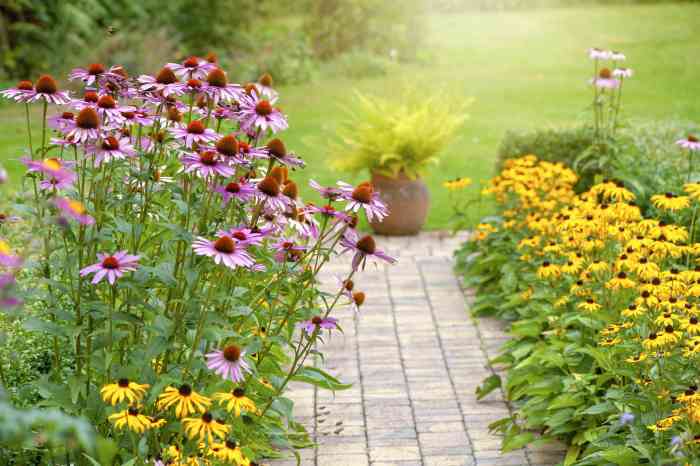When it comes to creating beautiful and vibrant garden borders, selecting the right plants is crucial. From perennials to annuals, shrubs to ornamental grasses, there’s a wide range of options to choose from. In this guide, we’ll explore the best plants for garden borders, considering factors such as climate, sun exposure, and design principles.
Types of Plants for Garden Borders

Garden borders add beauty and definition to your landscape. When choosing plants for your border, it’s important to consider the height, spread, and blooming period of each plant. You’ll also want to choose plants that are well-suited to your climate and soil conditions.
Perennials
Perennials are plants that live for more than two years. They typically die back to the ground in the winter, but they will re-emerge in the spring. Perennials are a great choice for garden borders because they provide year-round interest.
- Height:6 inches to 4 feet
- Spread:6 inches to 3 feet
- Blooming period:Spring, summer, or fall
Some popular perennials for garden borders include:
- Coneflower
- Daylily
- Hosta
- Salvia
- Yarrow
Annuals
Annuals are plants that complete their life cycle in one year. They are typically grown from seed and will bloom for a few months before dying back. Annuals are a great way to add color and variety to your garden border.
- Height:6 inches to 3 feet
- Spread:6 inches to 2 feet
- Blooming period:Spring, summer, or fall
Some popular annuals for garden borders include:
- Petunia
- Marigold
- Zinnia
- Cosmos
- Snapdragon
Shrubs
Shrubs are woody plants that typically have multiple stems. They can be evergreen or deciduous. Shrubs are a great choice for garden borders because they provide structure and height.
- Height:2 feet to 10 feet
- Spread:2 feet to 6 feet
- Blooming period:Spring, summer, or fall
Some popular shrubs for garden borders include:
- Boxwood
- Hydrangea
- Rose
- Spirea
- Viburnum
Ornamental Grasses
Ornamental grasses are grasses that are grown for their beauty rather than their food value. They can add height, texture, and movement to your garden border.
- Height:1 foot to 8 feet
- Spread:1 foot to 4 feet
- Blooming period:Summer or fall
Some popular ornamental grasses for garden borders include:
- Feather reed grass
- Japanese blood grass
- Maiden grass
- Purple fountain grass
- Zebra grass
Factors to Consider When Choosing Plants

When selecting plants for garden borders, several factors must be considered to ensure their success and aesthetic appeal. These factors include climate and soil conditions, sun exposure and shade tolerance, water requirements and drought tolerance, size and shape of the border, and color combinations and seasonal interest.
Climate and Soil Conditions
The climate and soil conditions in your area will determine which plants will thrive in your garden border. Consider the average temperature, rainfall, and humidity levels, as well as the type of soil you have. Some plants are more tolerant of extreme temperatures or poor soil conditions than others.
Sun Exposure and Shade Tolerance
The amount of sunlight your garden border receives will also influence your plant choices. Some plants require full sun, while others can tolerate partial shade or even full shade. Consider the orientation of your border and the amount of shade cast by nearby trees or buildings.
Water Requirements and Drought Tolerance
The water requirements of your plants will depend on the climate and soil conditions. Some plants are more drought-tolerant than others and can survive with less frequent watering. If you live in an area with limited rainfall, you may want to choose plants that are more drought-tolerant.
Size and Shape of the Border
The size and shape of your garden border will also affect your plant choices. Tall, upright plants are best suited for the back of the border, while shorter, spreading plants can be used in the front. Consider the overall shape of the border and choose plants that will create a balanced and visually appealing design.
Color Combinations and Seasonal Interest
The color combinations and seasonal interest of your plants can add beauty and variety to your garden border. Choose plants that bloom at different times of the year to ensure that your border is always full of color. Consider the color scheme of your home and garden when selecting plants to create a cohesive look.
Design and Arrangement of Plants: Best Plants For Garden Borders

Creating an eye-catching and well-balanced garden border requires careful planning and arrangement of plants. By employing design principles such as repetition, contrast, and layering, gardeners can achieve visual interest and year-round beauty.
Creating Visual Interest and Balance
To create a visually appealing border, consider the height, form, texture, and color of the plants you choose. Arrange taller plants at the back and shorter ones in front to create a tiered effect. Vary plant shapes, from upright and columnar to rounded and cascading, to add visual interest.
Mix different leaf textures, such as smooth, ruffled, or spiky, to enhance the border’s overall appeal.
Using Repetition and Contrast, Best plants for garden borders
Repeating certain plants throughout the border creates a sense of unity and rhythm. Contrast, on the other hand, adds drama and highlights focal points. Plant contrasting colors, textures, or shapes side by side to create visual impact. For example, pair a blue delphinium with a yellow daylily, or a spiky yucca with a soft-leaved hosta.
Incorporating Focal Points and Layering
Create focal points by placing taller or more striking plants in strategic locations. This draws the eye and adds depth to the border. Layer plants in front of and behind each other to create a sense of movement and depth.
Plant taller plants at the back, mid-sized plants in the middle, and groundcovers or low-growing plants in the front.
When selecting the best plants for garden borders, consider not only aesthetics but also the needs of the local ecosystem. For instance, plants that attract beneficial insects can enhance biodiversity. Similarly, in the world of exotic pets, choosing the right plants for crested geckos is crucial for their well-being.
From live plants that provide hiding spots and humidity to artificial ones that offer visual stimulation, the options are diverse. Discover the best plants for crested geckos and elevate their living environment. Returning to the topic of garden borders, remember that a well-planned selection of plants can create a vibrant and sustainable landscape.
Designing for Year-Round Interest
Extend the beauty of your garden border throughout the year by choosing plants with varying bloom times and foliage colors. Include evergreens for winter interest, and plants that bloom in different seasons to ensure continuous color and visual appeal.
Maintenance and Care of Garden Borders

Maintaining garden borders requires ongoing care to ensure their health and beauty. This includes regular watering, fertilizing, mulching, weeding, pruning, deadheading, and pest and disease control.
For those looking to add a touch of serenity to their garden borders, consider incorporating plants known for their positive feng shui energy. Best plants for feng shui include bamboo, jade plant, and peace lily, believed to promote harmony, prosperity, and well-being.
These plants can complement the vibrant colors and textures of other border favorites, enhancing the overall aesthetic and creating a calming outdoor sanctuary.
Watering and Fertilizing
Water borders regularly, especially during hot and dry weather. Water deeply to encourage strong root growth. Fertilize borders every few weeks with a balanced fertilizer to provide essential nutrients.
Mulching and Weeding
Mulch around plants with organic matter, such as bark chips or compost, to suppress weeds, retain moisture, and regulate soil temperature. Remove weeds regularly to prevent them from competing with plants for water and nutrients.
Pruning and Deadheading
Prune borders regularly to remove dead or diseased growth, shape plants, and encourage new growth. Deadhead spent flowers to prevent seed production and encourage further blooming.
Pest and Disease Control
Monitor borders for pests and diseases and take appropriate control measures. Use organic methods, such as companion planting, natural predators, or insecticidal soap, whenever possible.
When it comes to choosing the best plants for garden borders, there are many factors to consider, including the amount of sunlight, the soil conditions, and the desired height and spread of the plants. Some of the best plants for garden borders include perennials, such as hostas, daylilies, and irises, which will come back year after year.
If you’re looking for something that will add a splash of color to your cubicle, consider best plants for a cubicle , such as peace lilies, spider plants, or snake plants. These plants are known for their ability to thrive in low-light conditions and can help to purify the air in your workspace.
When selecting plants for your garden borders, it’s important to choose plants that are well-suited to your climate and that will provide year-round interest.
Specific Plant Recommendations
Choosing the right plants for your garden borders is essential for creating a visually appealing and thriving landscape. Here are some specific plant recommendations organized by category to help you make informed choices.
Perennials
Perennials are plants that live for more than two years, providing color and interest to your garden borders year after year.
| Plant | Bloom Time | Height | Spread |
|---|---|---|---|
| Salvia | Spring to Fall | 1-3 ft | 1-2 ft |
| Hosta | Summer | 1-3 ft | 2-4 ft |
| Daylily | Summer | 2-4 ft | 2-3 ft |
| Coreopsis | Summer | 1-2 ft | 1-2 ft |
| Sedum | Summer to Fall | 1-2 ft | 1-2 ft |
Annuals
Annuals are plants that complete their life cycle in one growing season, adding bursts of color and variety to your garden borders.
| Plant | Bloom Time | Height | Spread |
|---|---|---|---|
| Petunia | Spring to Fall | 6-12 in | 1-2 ft |
| Impatiens | Spring to Fall | 1-2 ft | 1-2 ft |
| Marigold | Summer | 1-2 ft | 1-2 ft |
| Zinnia | Summer to Fall | 1-3 ft | 1-2 ft |
| Cosmos | Summer to Fall | 2-4 ft | 1-2 ft |
Shrubs
Shrubs provide structure and height to garden borders, adding year-round interest with their foliage and seasonal blooms.
| Plant | Height | Spread | Foliage |
|---|---|---|---|
| Boxwood | 2-8 ft | 2-6 ft | Evergreen |
| Hydrangea | 3-6 ft | 3-5 ft | Deciduous |
| Azalea | 3-6 ft | 3-5 ft | Evergreen or Deciduous |
| Rhododendron | 4-10 ft | 4-8 ft | Evergreen |
| Viburnum | 5-10 ft | 5-8 ft | Deciduous |
Ornamental Grasses
Ornamental grasses add texture and movement to garden borders, creating visual interest even in the winter months.
| Plant | Height | Spread | Texture |
|---|---|---|---|
| Miscanthus | 3-6 ft | 2-4 ft | Fine |
| Pennisetum | 2-4 ft | 2-3 ft | Medium |
| Panicum | 2-4 ft | 2-3 ft | Coarse |
| Stipa | 2-3 ft | 2-3 ft | Fine |
| Calamagrostis | 3-6 ft | 2-4 ft | Medium |
Closing Summary
By following the tips and recommendations Artikeld in this guide, you can create stunning garden borders that will add color, texture, and interest to your outdoor space. Whether you’re a seasoned gardener or just starting out, this guide will provide you with the knowledge and inspiration you need to design and maintain a thriving border.
Commonly Asked Questions
What are the most popular perennials for garden borders?
Some of the most popular perennials for garden borders include lavender, hostas, daylilies, and salvia.
What are some low-maintenance plants for garden borders?
Some low-maintenance plants for garden borders include sedum, yarrow, and ornamental grasses.
How can I create a year-round interest in my garden border?
To create year-round interest in your garden border, choose plants that bloom at different times of the year and include plants with different foliage colors and textures.